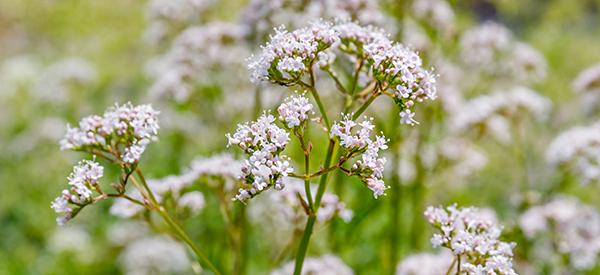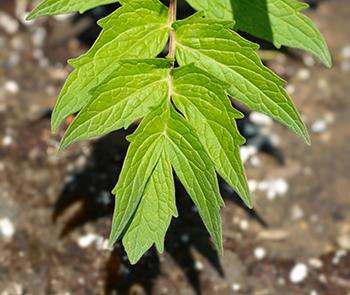
Valerian
Valerian (Valeriana officinalis) is a household name in complementary and homeopathic herbal remedies for inducing sleep. This herb has hypnotic, sedative, and anti-spasmodic properties. It is often a common ingredient in sleep aid medicine and mild sedatives. Some companies are also working on incorporating valerian root in sleep-supporting ice cream and beverages. These products are marketed as food supplements and not as food and remain under the close watch of the FDA.
The roots are the most valuable part of the valerian plant, and they are obtained for medicinal purposes. Oil extracts from its leaves are also used as an ingredient for baked goods. Although its roots exude an unpleasant stale stench, its flowers produce a pleasant smell that is used in perfume preparation. Valerian is also used as a cat relaxant or an alternative to catnip. In areas of pests infestations, it is often used as a vermin trap because of its foul smell.
The valerian plant has had a prominent status in medicinal herbs for thousands of years. It is traced back to the era of the Greek physician Hippocrates as a prescribed medicine for sleep disorders. In England, valerian was used as a popular relief from stress following the air raids during WWII. Modern research focused on the effectiveness of the plant in reducing anxiety and improving the quality of sleep.
Where Valerian Is Found
 Valerian is endemic in Europe and some parts of Asia. They grow in average garden soils and are often found along riverbanks and marshy grasslands. The herb is non-native in the US but proliferated in the northern parts due to its adaptability to cooler climates. While it is cultivated as a medicinal plant in most gardens, Connecticut and Wisconsin listed valerian as a noxious weed.
Valerian is endemic in Europe and some parts of Asia. They grow in average garden soils and are often found along riverbanks and marshy grasslands. The herb is non-native in the US but proliferated in the northern parts due to its adaptability to cooler climates. While it is cultivated as a medicinal plant in most gardens, Connecticut and Wisconsin listed valerian as a noxious weed.
Related: The Complete Map of Edible Plants: Find Out What You Have in Your Area! (Video)
How To Identify Valerian
Valerian is an invasive flowering perennial plant that grows up to 2 meters. It can grow tall and slender but its stems may flop in full shade. This deciduous plant has a clumping habit with a rapid growth rate. Its trumpet-like star flowers contain both types of reproductive organs.
 Leaves. Valerian has a set of clumping or rosette basal leaves that are compound with odd to pinnate shapes. It appears in the lower part of the stem consisting of about 4 to 9 pairs of leaflets. Valerian leaves are green and covered with prickles. The leaf type changes as it moves higher up the stem. It becomes shorter, less lobed, and with shorter petioles.
Leaves. Valerian has a set of clumping or rosette basal leaves that are compound with odd to pinnate shapes. It appears in the lower part of the stem consisting of about 4 to 9 pairs of leaflets. Valerian leaves are green and covered with prickles. The leaf type changes as it moves higher up the stem. It becomes shorter, less lobed, and with shorter petioles.- Flowers. The fragrant flowers of the valerian bloom in white or pink blossoms from June to August. The showy flowers are star-shaped and fused into a cyme or central flower with peripheral blooms. They are arranged into umbels or clusters that are about 2 to 5 inches across.
 Roots. Valerian has a short and cylindrical rhizome, and bushy round and slender roots. These roots are yellow to brown and contain yellowish-green or brownish-yellow volatile oil.
Roots. Valerian has a short and cylindrical rhizome, and bushy round and slender roots. These roots are yellow to brown and contain yellowish-green or brownish-yellow volatile oil.- Fruits and Seeds. Valerian fruits are dry and small egg-shaped capsules. It is yellow and covered with a tuft of white hair containing one oblong seed each.
- Stem. Valerian has numerous grooved and hollow stalks. In favorable conditions, the stems would grow erect and reach a height of up to 4 feet. The stems are sparsely-leaved with fine hairs that are denser at the nodes.
Related: Plant Identification Guide – 400 Wild Plants That You Can Forage For (Video)
Valeriana officinalis is a member of the Valerianaceae family of about 350 herbaceous species. Valerian has three subspecies: ssp. officinalis, ssp. sambucifolia, and ssp. tenuifolia.
The common valerian, or V. officinalis, is the most popular species of valerian used for medicinal purposes. Other varieties of valerian include:
- occidentalis or Western Valerian
- celtica or Alpine Valerian
- sitchensis or Sitka Valerian
How To Grow Valerian
Valerian propagates through seeds and root division. Some nurseries and garden stores may sell both seeds and full-grown valerian plants. Often, you will find valerian seeds for planting in some online stores. This hardy plant can grow in a variety of conditions but may thrive abundantly in moist and swampy areas.
Growing Valerian from Seeds
 You can grow valerian seeds in autumn, spring, or mild spells of winter. If sowing during the summer, make sure to keep the plants well-watered in their growing phase.
You can grow valerian seeds in autumn, spring, or mild spells of winter. If sowing during the summer, make sure to keep the plants well-watered in their growing phase.
Sow the valerian seeds in a rich and moist potting mix and tamp down the soil.
Keep the tray well-watered and at a temperature between 65 to 68°F until the seeds germinate at one to two weeks.
Transplant the valerian seedlings once they are established and are already 5 to 6 inches tall. The best time for transplanting is in early spring when the ground can be worked on easily.
Related: I Stopped Spending Money At The Pharmacy By Growing These 10 Plants (Video)
Growing Valerian from Root Division
The clumping valerian plant can be divided for propagation and is best done during spring or autumn. Make sure to choose a large clump instead of solitary ones as these are more established. Dug up the clump and break it apart, making sure that each division has a set of roots.
Plant the valerian root division in moist soil about 12 to 24 inches apart. Water them well until new valerian plants emerge. Once established, a valerian plant is trouble-free and hardly needs maintenance in growing and reproducing.
Plant Care and Maintenance
 Overwatering is not an issue with valerian since it can survive in wet and marshy areas. In summer, regular watering is necessary to keep them healthy.
Overwatering is not an issue with valerian since it can survive in wet and marshy areas. In summer, regular watering is necessary to keep them healthy.
The plant will die in winter, but new valerian plants will emerge back during spring. It particularly loves the full sun, rich soil, and moist environment.
Valerian self-seed freely and may invade your garden. To avoid this, you may cut the stem down once the flowers fade and before the seeds form.
This plant requires little maintenance and is hardy in zones 4 to 8.
If you are growing valerian mainly for medicinal purposes, you need to clip all of its blossoms. This way, the nutrients will be concentrated at the roots, and it produces a high oil concentration.
Related: 10 Plants That You Should Never Plant Together (Video)
How To Harvest Valerian
 After one year, valerian root is ready for harvest. But most herbalists prefer two-year-old plants when the roots are of good size. Harvesting the plant for its oil is best done in early fall. During this season, the roots have the highest concentration of oil.
After one year, valerian root is ready for harvest. But most herbalists prefer two-year-old plants when the roots are of good size. Harvesting the plant for its oil is best done in early fall. During this season, the roots have the highest concentration of oil.
 Harvesting valerian roots is as simple as digging up the entire plant from the soil. Wash the plant thoroughly without removing the roots from its stem.
Harvesting valerian roots is as simple as digging up the entire plant from the soil. Wash the plant thoroughly without removing the roots from its stem.
Remove all the fibrous roots and hang them in an airy area for several weeks to dry. Valerian emits a stale and sweat-like stench and is better dried outdoors under the cover.
Once completely dry, you can cut away the stems and store the dried roots in a sealed container. Store the leaves and the roots in a separate container.
Keep the containers in a cool and dry place until you are ready to use your valerian herb for remedies.
What Valerian Root Is Good For And Natural Remedies Made From It
Valerian is a powerful nervine, an herb that has therapeutic effects on the nervous system. Its most effective medicinal function is in treating insomnia and neurological disorders. Its root compound works on the nervous system to promote deep relaxation and relieve anxiety. It is also an effective medicine for mood swings, paranoia, and phobias.
The anticonvulsant property of valerian makes it a therapeutic alternative for epileptic patients. With its ability to relieve oxidative stress, it is considered a treatment for Parkinson’s disease.
The essential oil of valerian contains compounds that can lower blood pressure, and regulate the heart rate. It can regulate blood lipid levels that can promote cardiovascular health. Valerian is also a diuretic that is used for treating urinary tract disorders.
In children, studies show that it can help improve memory to support their focus and learning. It can also manage hyperactivity in children with ADHD.
Valerian is a popular herb for treating women’s reproductive problems. For many years, it is considered a potent home remedy for alleviating menstrual and uterine problems like dysmenorrhea and endometriosis. Valerian root has phytoestrogens, making it an effective treatment for hot flashes in menopause.
With its antifungal property, valerian can curb the growth of molds on any surface. Thus, it is an effective treatment for ulcers, eczema, and minor wounds when applied externally.
When taken properly, the valerian root is seen to cure the following health conditions:
- Heart problems (arrhythmia, bradycardia, palpitation, angina, etc.)
- Sleep disorders (insomnia, sleep apnea, jet lag)

- Panic attack, anxiety
- Epilepsy
- Parkinson’s disease
- Nerve disorders
- Neurological conditions
- Menstrual cramps, endometriosis
- High blood pressure
- Urinary problems
- Lower back pains
- Minor wounds and skin problems
- Migraine
- Abdominal cramps and flatulence
What Parts Of The Valerian Are Used For Remedies
In herbal medicine preparation, the root of the valerian is considered the most valuable. It is the source of essential oils that are obtained and processed for commercial use.
The roots of the valerian are dried and made into decoction, concoction, infusion, or tea for alleviating health conditions. Infusion is the popular way of consuming valerian root for insomnia and anxiety. It is the most potent and less processed form of the herb. However, because of its obnoxious odor, it is not very well-preferred by users today. Thus, dried valerian is often dispensed as a capsule, extract, or tincture.

Valerian root is very potent because of its compound concentration. For people who want a milder effect, the valerian leaves are the better option. The leaves are also steeped as tea or ground into powder and put into empty capsules.
To try the potency of valerian, here is a powerful recipe you can brew. A little caveat though, valerian root may diffuse an unpleasant smell. But it is worth a try to calm your nerves and relax your mind and body.
Related: A Before-Bed Recipe to Sleep Like a Baby Again (Video)
Relaxing Valerian Infusion
Ingredients:
- 1-2 tsp valerian root
- 1 cup of water
- Raw honey, optional
Steps:
- Put the valerian root in a tea infuser with a cover. If none, a jar or container with a cover is fine.

- Bring water to a simmer but not boiling and pour it over the valerian root.

- Cover the tea infuser/container to retain all the volatile oils. Let the valerian root infuse for about 30 minutes.

- Remove the infuser from the cup. If using a covered container, strain the infusion into a cup and enjoy. You may also add raw honey to manage its unpleasant smell.

How To Use This Remedy:
Valerian infusion is potent when it is freshly brewed and gets less effective the longer it sits. So, prepare the infusion only when you are ready to consume it.

If you want to use valerian tea as a sleep aid, consume it at least 30 minutes to two hours before bedtime. When using the supplement, the safe doses are between 300 to 600 mg daily. Do not take valerian root for more than 6 weeks to avoid its adverse effect.
Formulated to help you fall asleep faster and stay asleep longer, the Sleep Blend Tincture is also a convenient, easy-to-use blend of hops, valerian, German chamomile, passionflower, and magnesium glycinate. Visit the apothecary today to read about these outstanding herbs for promoting deep, rejuvenating sleep.
What Plants Resemble Valerian
| Feature | Valerian (Valeriana officinalis) | Wild Carrot (Daucus carota) | Patrinia (Patrinia scabiosifolia) |
|---|---|---|---|
 |  |  | |
| Size | 4 to 5 ft | 1 to 3 ft | 3 to 6 ft |
| Leaves | Green; with prickles; rosette; compound; opposite | green; roughly-haired; alternate | Dark green; glossy; compound; opposite; serrate |
| Flowers | White or pink; star-shaped; umbel; cyme | Dull white to pink; dense umbels; | Yellow; star-shaped; umbel |
| Stem | Hollow; numerous; sparsely-leaved; hairy | Solid; stiff; roughly-haired | Upright; branching; herbaceous |
| Scent | unpleasant | Carrot-like smell | No noticeable scent |
Warnings And Cautions
Valerian root is likely safe for consumption in moderate amounts. Excessive consumption may cause side effects like headaches and uneasiness.
The safety of valerian roots in pregnant and breastfeeding mothers is not yet established. Thus, valerian should be avoided by women in this group. Do not use valerian in children without professional supervision. They are not also for use in children below three years old.
When driving a motor vehicle or doing jobs that require attentiveness, do not take valerian supplements. It can cause drowsiness and may temporarily impair reflexes and alertness.
If you are scheduled for surgery, taking sedative drugs, and anxiolytic, do not use valerian. It interacts with prescription medication and causes harmful side effects. You should not also take valerian with alcohol, St. John’s Wort, kava-kava, and L-tryptophan.
Always consult a medical professional when taking herbal remedies like valerian.
Mugwort Pillow for Insomnia and Anxiety
Homemade Sleep Blend Tincture (Learn More)
Best Herbs and Foods to Fight Adrenal Fatigue

 Leaves. Valerian has a set of clumping or rosette basal leaves that are compound with odd to pinnate shapes. It appears in the lower part of the stem consisting of about 4 to 9 pairs of leaflets. Valerian leaves are green and covered with prickles. The leaf type changes as it moves higher up the stem. It becomes shorter, less lobed, and with shorter petioles.
Leaves. Valerian has a set of clumping or rosette basal leaves that are compound with odd to pinnate shapes. It appears in the lower part of the stem consisting of about 4 to 9 pairs of leaflets. Valerian leaves are green and covered with prickles. The leaf type changes as it moves higher up the stem. It becomes shorter, less lobed, and with shorter petioles. Roots. Valerian has a short and cylindrical rhizome, and bushy round and slender roots. These roots are yellow to brown and contain yellowish-green or brownish-yellow volatile oil.
Roots. Valerian has a short and cylindrical rhizome, and bushy round and slender roots. These roots are yellow to brown and contain yellowish-green or brownish-yellow volatile oil.






This is a beautiful article!
Thank you for this information keep them coming ^^
This is wonderful. I’ve been taking Valerian Root capsules for years as needed for my restless legs, but, I had no idea it did so much else. I could get off most of my meds if I could take it daily. Where can I buy some seeds?!!
Thank you for sharing
Valerian Root tea bags
https://amzn.to/3Duu0wi
Bulk Organic Valerian Root
https://amzn.to/3Lxvs3R
Stainless Steel Mesh Tea Ball
https://amzn.to/36dBXJM
Wonderful
Thank you for what you do. I believe we will continue to move toward natural Therapies and your help is immeasurable.